The hero of the pictorial record of Plains Indian life described elsewhere in the present number of the JOURNAL carries a shield to which reference is made on p. 17. There are other shields represented on the robe. All are of the round variety which is characteristic of the region concerned. A group of shields of this pattern, all but two of which are exhibited in the Plains Indian room of the MUSEUM, is the subject of the following notes.
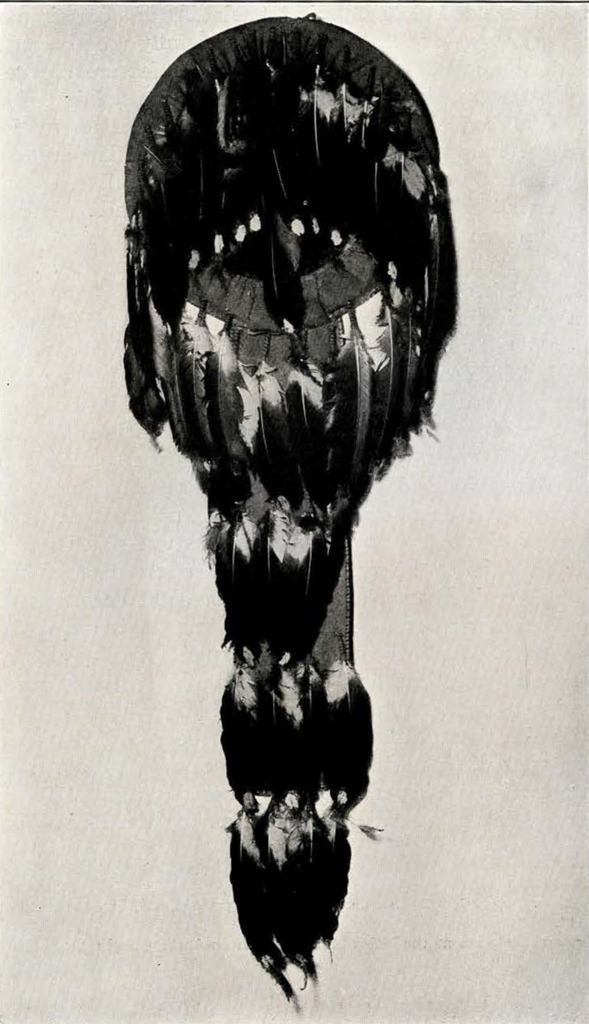
Museum Object Number: NA3508
Image Numbers: 12813, 12814
The round shield or target is the characteristic New World shield. Other forms occur, but among aboriginal American users of shields, this type is predominant, and the geographical limits of its distribution suggest that its use spread from one centre, probably Mexico.1 All the shields dealt with here are made of hide, which was the only material used for shields among the Indians of the Plains; their neighbours of the southwest, the Pueblo tribes, made their round shields of wicker and of a heavy fabric of cotton as well as of thick rawhide. In both regions the shields bore symbolical painted devices,2 as they did also in Mexico.3
The indigenous animals which afforded hide of suitable thickness were the elk and the buffalo. In later times horsehide and cowhide came into use. The introduction of firearms might have been expected to render the rawhide shield obsolete, but the protection afforded by it had probably been from very early times conceived as largely of a magical nature, and the shield long continued to be a part of the equipment of the mounted warrior armed with musket or rifle. Its early use in ceremonies of a magico-religious character also ensured its survival for similar purposes after its abandonment by the warrior in the field. Writing in 1907 of the Dakota, Wissler says, “Practically no shields of buffalo hide are to be found in the hands of the surviving Dakota; but in social and religious ceremonies, models or shield-covers of buckskin or cloth, upon which are painted the designs formerly placed on shields, are often used.”4

Museum Object Number: NA3508
Image Numbers: 12813, 12814
These shields are regularly dished, that is, so shrunken and modelled in the making as to present a convex obverse to the enemy, and to provide, with the assistance of a swiftly observant eye and a shield arm quickly responsive to such observation, an always inclined surface to the impact of a missile or the thrust of a spear and thus cause either to glance aside. It may be doubted, in spite of assertions to the contrary, that what in the way of form or manipulation would stop an arrow could be similarly effective except by accident against a bullet. It was not even infallible when opposed to the weapons it was anciently designed to meet ; witness an arrow hole and two spear thrusts respectively in two of the examples of shields figured here, Fig. 16 and Fig. 13.
Dr. Wissler’s analysis of the motives which governed the former use and the later retention of the shield by the Dakota is interesting and suggestive. He says, ” When the enemies of the Dakota were armed with native weapons, the shield had some value in itself, because few arrows could get through it, and it was of sufficient strength to ward off a blow from a club or an axe; but even at that time the designs and medicine objects tied to the shield seem to have been regarded as of greater importance than the mechanical properties of the shield itself. It was the power represented by the design to which the owner of the shield looked for protection. Naturally, with the introduction of firearms, shields ceased to have a real protective value; but their designs were still looked upon as capable of affording protection against evil. According to the statements of some old men who still have faith in protective designs, the ancient shield manifested its power upon the mind of the enemy by influencing them to shoot at the shield rather than at the exposed parts of the body of its bearer. But when firearms were introduced, experience demonstrated that the shield was no longer a desirable object in battle, because the same influence that drew arrows to it drew bullets also, and in this case with fatal results. From this they concluded that guns represented a mystic power superior to that of shield-designs, but that the latter were still efficacious, except when so overpowered. . . . These men seem to have grasped the idea that the shield, being a conspicuous object, would attract the attention and thus the aim of the enemy; but they confused this psychological explanation of the observed facts with a mystic conception that the magic power of the design upon the shield was the cause or force that reached out and lay [sick hold of the attention of the enemy. Yet the introduction of firearms did not relegate the shield to oblivion ; and shield-designs are still cherished . . . because they represent a kind of individual totem or protective power.5

Museum Object Number: 38368
Image Number: 12868
It is also interesting to recall in this connection the statement of Maximilian of Wied referred to on p. 33 here, about the symbolical use and the decoration of the ramrod among the Mandan, Hidatsa, and Teton Dakota, remarks which seem to indicate that the ramrod, in virtue of being the implement which was used to charge the musket, had come to represent itself the superior death dealing power of the charge which it appeared to control. I infer that the decoration of the ramrod attached to the gun was symbolical of its magical energy, since the purely decorative treatment of an essential part of the marksman’s equipment could scarcely be regarded as important enough in itself to justify rendering that object so useless for its original purpose that it had to be duplicated and the marksman burdened with an extra piece of equipment.
The device on the shield was magical in no merely passive or defensive sense. As in military strategy the most effective defence may be an offensive, so the protecting shield in Dakota military magic extends the scope of its power into the field of offence. One of the shield covers described by Wissler bears as part of its device the zigzag symbol for lightning, of which we are told that it here represents “the death dealing power conferred upon the owner of such a shield-design”.6 The new magic concentrated, so to speak, in the ramrod comes to reinforce rather than to replace the old.
It does not seem clear whether the rawhide disc in itself was endowed with any part of the magical power that inhered in the whole apparatus with its painted cover and attachments of feathers, furs, and other pendent charms, or that, like a Congo fetish figure, the power resided in the attachments and was communicated to the object to which they were attached only so long as they remained in place. Of the twelve shields with which we are here concerned, eight have a painted device on the shield itself ; one other, also without cover, has for its only decoration, apart from traces of colour, thongs passed through slits in the two layers of hide of which it is made so as to form a number of circles concentric with the circumference of the shield, the primary object of this contrivance being evidently to hold the two layers of hide together. To the shields themselves or to their covers feathers are often attached, usually forming a fringe, which, falling from the upper part of the circumference, may obscure or completely hide the painted decoration of the shield or cover. Sometimes the feathers are attached to the shield or cover directly; sometimes indirectly by means of a band of woollen stuff, usually red, to which they are fastened. Fig. 1, a Shoshone shield, shows a good example of the kind of feathered streamer which is represented as an attachment of some of the shields on the painted buffalo robe. The shield shown in Fig. 3 has two covers, both painted, of which the outer forms a protection for the feathers which decorate the inner. Among the feathers of Fig. 5, a Dakota shield, are fastened several other objects having magical power—a bone whistle and two tails of some small animal. Such a shield with its cover enclosing magical objects is treated by the Blackfoot as a “medicine bundle,” according to Wissler.7

Museum Object Number: 38368
Image Number: 12867
The manufacture of a rawhide shield, as it was carried out in the thirties of the last century among the Dakota, is described by George Catlin8 as follows, “The process of smoking the shield’ is a very curious as well as an important one, in their estimation. For this purpose a young man about to construct him a shield digs a hole of two feet in depth in the ground and as large in diameter as he designs to make his shield. In this he builds a fire, and over it, a few inches higher than the ground, he stretches the rawhide horizontally over the fire, with little pegs driven through holes made near the edges of the skin. This skin is at first twice as large as the size of the required shield; but having got his particular and best friends (who are invited on the occasion) into a ring to dance and sing around it, and solicit the Great Spirit to instil into it the power to protect him harmless against his enemies, he spreads over it the glue, which is rubbed and dried in as the skin is heated; and a second busily drives other and other pegs inside of those in the ground, as they are gradually giving way and being pulled up by the contraction of the skin. By this curious process, which is most dexterously done, the skin is kept tight whilst it contracts to one half of its size, taking up the glue and increasing in thickness until it is rendered as thick and hard as required (and his friends have pleaded long enough to make it arrow and almost ball proof) when the dance ceases and the fire is put out. When it is cooled and cut into the shape that he desires, it is often painted with his medicine or totem upon it, the figure of an eagle, an owl, a buffalo, or other animal, as the case may be, which he trusts will guard and protect him from harm; it is then fringed with eagles’ quills or other ornaments he may have chosen, and slung with a broad leather strap that crosses his breast. These shields are carried by all the warriors in these regions [Upper Missouri River] for their protection in battles, which are almost invariably fought from their horses’ backs.”
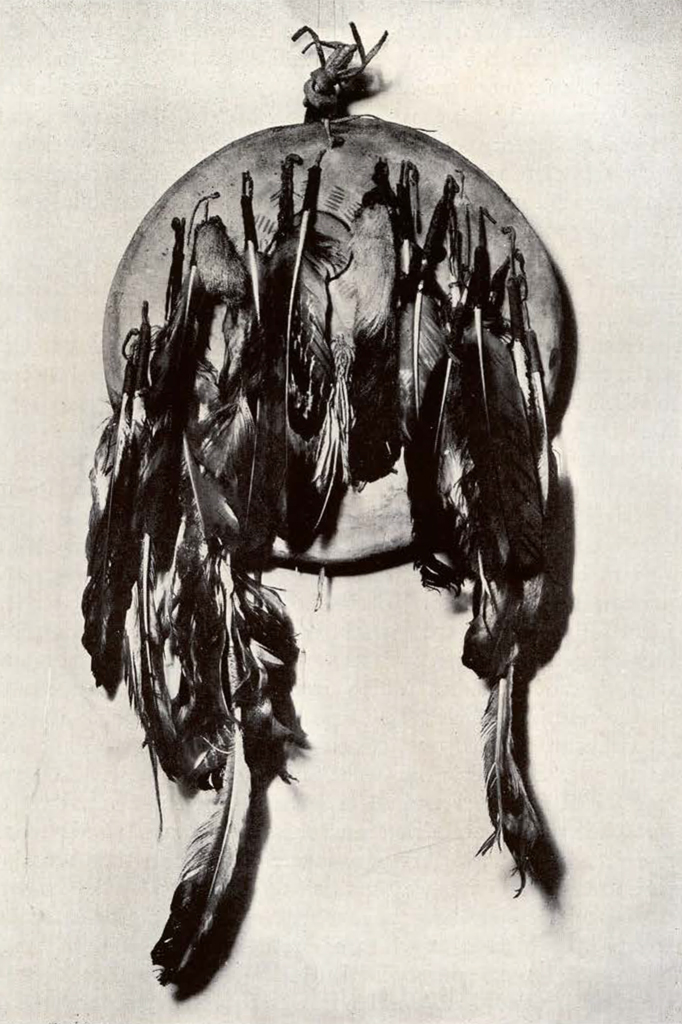
Museum Object Number: 21390
Image Number: 12901
A different method practised by another Plains tribe, the Blackfoot (Siksika) is described by Dr. Wissler.9 ” When a shield was to be made, a buffalo bull was skinned by cutting down the back. A large piece from the breast was taken, laid on the ground, hair side up, and soaked with boiling water which loosened the hair and caused the shrinkage. Finally the skin was turned over while wet and shaped over a small heap of earth and weighted down for drying. It was this heap of earth that gave the peculiar dish observed in these shields. The hair was removed with a stone, not with a scraper. The last step in the process was to trim the edges to a circle previously marked out by a stick.”
The Plains Indians made glue by boiling down the hoofs and the skin of the heads of animals. Perhaps this is the glue referred to in Catlin’s account of the making of a shield.
The device or cognizance painted on the shield or its cover is called by Catlin the “medicine or totem” of the owner. Speaking of such devices among the Dakota, Mallery10 says that they denote the gens of the owner or his personal designation or the marks of his rank. Later investigations show that shield devices among the Plains Indians in general had the character broadly indicated by Catlin rather than that of Mallery’s statement. For the Dakota and Blackfoot we have express statements to this effect11; a and Mooney12 sums up the information concerning the Plains region as follows, “The shield of the Plains warrior constituted his most sacred possession from the time when it was made for him or given to him soon after his first encounter with the enemy, until it was laid under his head in the grave, unless before that time bestowed on some worthy younger warrior or left as a precious sacrifice at the grave of wife or child. Every shield originated from a dream, in which the dreamer was told by the spirit how many shields he might make, how they must be painted and decorated, how the owner must paint and otherwise decorate himself and his pony, and what taboos and other sacred obligations he must observe through life in order to obtain the protection of the shield spirit, which might be a bird, a quadruped, a being of the tribal pantheon, or one of the personified powers of nature. The owner rarely made his own shield, but received it from the dreamer, usually an old warrior or recognized medicine man, who made it on request as he had been instructed, for a definite compensation in horses, blankets, or other property. . . . The cutting, painting, and decorating with feathers and other pendants were all matters of much ceremony, in which the maker was assisted by the candidate and by other shield owners, usually those carrying shields of the same pattern. During the progress of the work the young man was instructed in all the obligations connected with the shield, and at its completion the shield was formally consecrated in a sweat-house built for the purpose, and the whole ceremony concluded with a feast. The obligations included certain taboos, prayers, songs, and war cries, with a specific method of caring for the shield when in camp and of uncovering it before going into the fight. When not in use it was hung upon a tripod, usually facing the sun, or tied upon an upright pole.”

Museum Object Number: 21390
Image Number: 12902
According to Wissler13 this exposure to the sun was, among the Dakota, reserved for a class of shields similar to the “medicine-shields” of the Blackfoot, which latter were those associated with the most important shield rituals. Both Catlin and Maxmilian of Wied figure shields suspended in this manner.
Almost inevitably, it seems, so far as the shields figured here are concerned, the shape of the field to be decorated imposed upon the designers the nature of their main designs. In nearly all cases these are based on a simple analysis of the circle, and a repetition of the outline of the given circular field. Fig. 7, which is to be regarded as a modified circle, has a central dark circular area from which issue short rays terminating in dots, the latter forming a broken line concentric, in intention, at least, with the outer circumference of the shield. Thongs passed through holes in the hide of which the shield is made at right angles to each other form discontinuous lines cutting each other at the centre of the shield and dividing the whole area into four sectors. In the case of the two covers of the shield represented in Figs. 3 and 4, we have again the smaller circular areas concentric with the larger, and groups of triangular rays which are in effect narrow sectors, while the whole group of rays in the lower part of the large circle formed by the shield is conceived as a sector, and forms with the central circular area that circle + sector ornament whose genesis as a geometrical form is illustrated in the crossed thongs and circle of Fig. 7, in the quillwork discs of the buffalo robes, shirts, moccasins, tipis, etc., and which appears here again in Figs. 8 and 9, while the manner in which it has originated by the selection of one from all the sectors into which a circle can be divided by a given number of radii is again illustrated in Figs. 2 and 10 with their small central areas and, respectively, four and eight radii.

Museum Object Number: 18627
Image Number: 12807
Even where details or main designs are not obviously based on the circle its influence on the suggestibility of the designer may sometimes be traced. In Fig. 3, the conventional representation of a dragon fly shows the natural uncompromisingly rectilinear outward thrust of wing transformed here into two concentric arcs of a circle, which, though not themselves concentric with the circumference of the shield, are undoubtedly unconsciously conditioned by its circularity, which perhaps may even have suggested also round tips for the dragon flies’ tails.
Similarly in the case of the shield, Fig. 11, the curve of the buffalo horns follows that of the circumference of the shield, the boss that rises between them is not merely a slight concession to realism, but more likely, or at least as much, a yielding to the pull of the heavily outlined outer curve. In a case like the bird of Fig. 12, in which there is a determined attempt at realism, the same influence can, I think, be traced in the bold curves of the outline of head, beak and talons, and the sweeping curve of the wings; while the legs are disposed as if the designer wished to make sure that they would fall well within the circle which might be completed by joining and producing the curves of the outlines of the wings and beak.
One of the shields pictured here, Fig. 13, exhibits well what among the Plains Indians is the commonest, and is perhaps the oldest, form of decoration of the shield,14 namely that in which the whole obverse is covered with concentric rings. This comes from New Mexico from the pueblo of Jemez and is a good old example. Two of the shields pictured on the Dakota buffalo robe described elsewhere in this issue of the JOURNAL are decorated in this simple fashion, and the means employed to fasten together the two thicknesses of hide of which the shield, Fig. 14, is made, affords an example of a similar form of decoration without the use of colour. Three other shields in the group, Figs. 8, 9 and 15, from this southwestern region, one of which is said to have been Comanche in origin and to have been used by Geronimo’s Apaches (Fig. 9), are evidently influenced by other Pueblo modes in the decorative forms employed and the use of colours. The same thing is perhaps less obviously true of the decoration of the cover of the Apache shield, Fig. 10.

Museum Object Number: 38566
Image Number: 12792
One of the shields of southwestern origin bears in duplicate on each side of the central sun ornament the representation of what appears to be a serpent with a cross just outside the opening of its gaping jaws. At first sight this looks like a modern attempt to copy some published restoration of the great serpent mound of Ohio. But on this assumption it is not easy to account for the cleft tail (or second head) and the fact that the cruciform figure which would represent the so called altar of the Ohio mound is placed without the opening of the jaws, or that this figure is a cross at all. I do not know of any of the proposed restorations of the serpent mound which show these features. (Fig. 8.)
The shield which appears here as Fig. 16 is one of the oldest in the MUSEUM’S collections. It is a Pima shield and was collected by F. W. Hodge in 1887. It was among several old shields in this Museum which were examined by James Mooney some years ago. He left the following note on a tag attached to it.
“Collected by F. W. Hodge (Bureau of American Ethnology) from Pima warrior in Salt River valley, Arizona, 1887, and later presented to Philadelphia Museum. Arrow hole from Apache in face. Figured in Wilson’s Swastika15 and from that to Russell’s Pima paper16 in Report, Bureau of American Ethnology.
“[The] swastika is [the] Pima tribal totem, property mark, and cattle brand. From analogy with Plains symbolism [it] probably here symbolizes and invokes spirit protection from [the] four cardinal points.”
The authority for the statement about the hole in the shield at the end of one arm of the swastika is given by Wilson as follows, “This shield is the property of Mr. F. W. Hodge, of the Bureau of Ethnology. He obtained it from a Pima Indian in Arizona, who assured him that the hole at the end of the lower arm of the Swastika was made by an arrow shot at him by an Indian enemy.”17

Museum Object Number: 38568
Image Number: 12812
Only remarking that the word totem was probably used by Mr. Mooney in a wider sense than would be advisable to-day to mean something like an amulet or charm; and that analogies like the one suggested are often misleading in view of our vague and partial knowledge of the symbolism of both these regions, I will pass on to quote from Russell’s account of the Pima one of the few descriptions we have of the Indian use of the shield in actual fighting.
“The fighting men were divided into two parties, those who used the bow and those who fought with club and shield. When advancing upon the enemy, the warrior crouched so that the comparatively small shield protected his entire body. He also leaped from side to side for the double purpose of presenting a more difficult target and of bewildering the enemy and thus unsteadying [sic] their nerves through the suggestion of magic. . . . The shield, with its magic symbols in brilliant colors, is kept in rapid motion not only from side to side but also revolving by the reciprocal twist of the bearer’s forearm.”18
The shields were of rawhide like the one figured. The clubs were short and heavy, made of mesquite and ironwood. “Their appeal to the God of War was expressed by the sun symbols that decorated the shields. . . . Crouching low, springing quickly with whirling shield that concealed the body, in feather headdress and battle colors, they must have presented a terrifying spectacle.”19
Incidentally, it may have been noted, in connection with the remarks quoted concerning this shield, we have had three, or at least two, conflicting explanations of the symbolical values of designs upon Pima shields. If the word totem, as employed by Mooney, means nothing more than an amulet or charm, we may eliminate one conflicting factor, as his explanation might then be taken as coinciding roughly with Russell’s “magic symbols.” But Russell has another explanation which it is not easy to reconcile with his own previous statement. In the passage last quoted the “sun symbols” of Pima shields express an “appeal to the God of War,” that is, I suppose, a prayer to this deity. In this case they can hardly be regarded as implements of magical procedure. From the terms in which this last statement is couched it would seem that the swastika, as being one of the symbols that decorate Pima shields, is to be regarded as a “sun symbol.” This would not accord very well with Mooney’s inference. The whole situation is, perhaps, fairly representative of the thorny ground to be traversed by interpreters of Indian symbolism. Probably the explanation which rests on principles of magic not unlike those which appear to underlie the shield decorations of the Plains Indians is most likely to be near the truth.
As we have seen, three of these shields are said to be Apache or to have been used by Apaches (Figs. 7, 9 and 10). The use was probably no more than ceremonial in two cases, at least. The shield of which Fig. 10 shows the cover may have been a practical arm of defence. “The Apache were the hereditary foes of the Pima from earliest tradition, and though they were no better fighters than their peacefully inclined desert brothers, the latter were constantly harassed through dread of sudden attack. The Pima, however, retaliated and learning that the Apache were early sleepers as well as early risers,
would often strike a sleeping camp before the waning moon had risen, retreating from the mountains by its pale light ere the Apache could rally in the streaking dawn.”20

Museum Object Number: NA7604
Image Number: 12806

Museum Object Number: NA5595
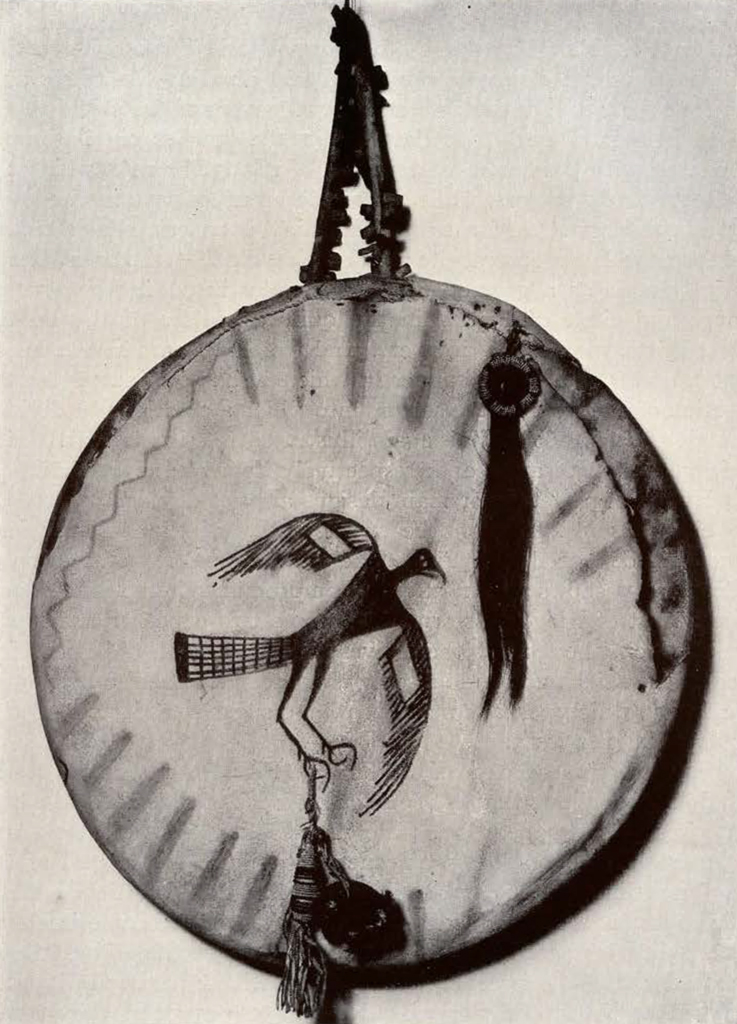
Museum Object Number: 38562A
Image Number: 12913
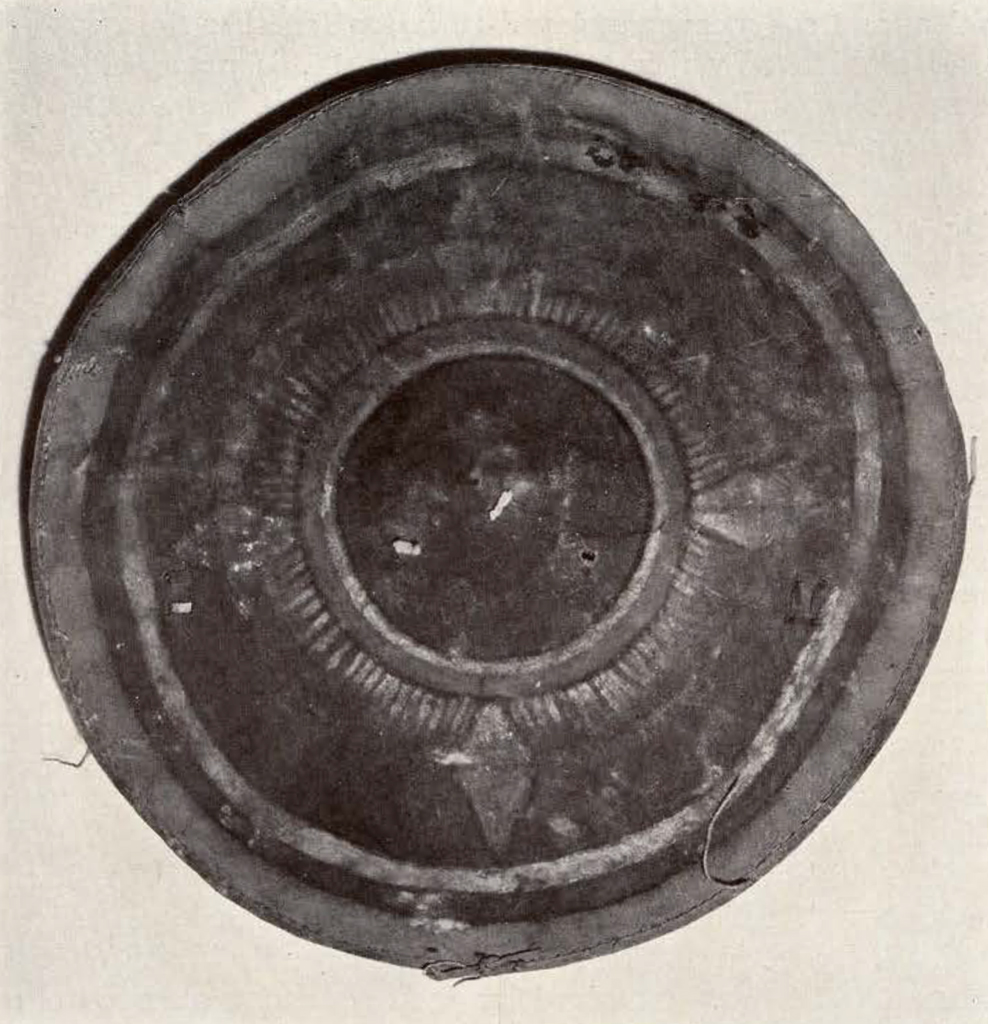
Museum Object Number: 38563
Image Number: 12793

Museum Object Number: 38564
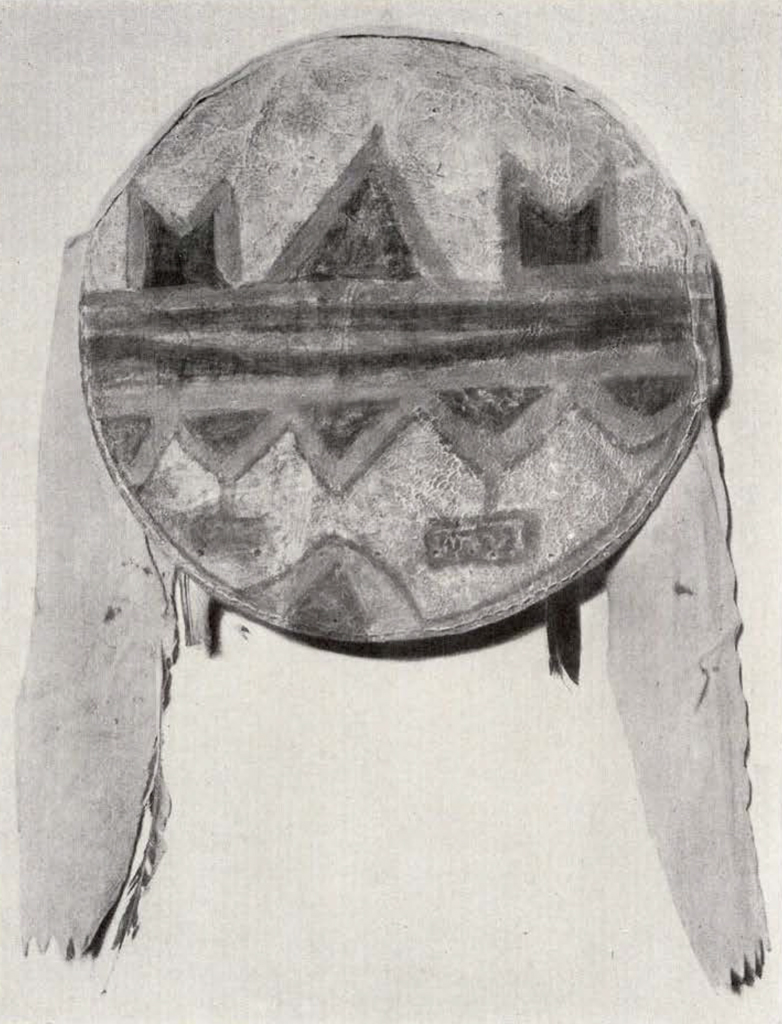
Museum Object Number: 38567

Museum Object Number: 22242
Image Number: 12765
1 C. Wissler, The American Indian, p. 138 (1923).↪
2 Cushing, quoted by W. Hough, Primitive American Armor, Report of the U. S. National Museum, 1893, p. 628.↪
3 Z. Nuttall, Internationales Archiv fur Ethnographic, V (1891).↪
4 Some Protective Designs of the Dakota, Anthropological Papers of the American Museum of Natural History, I (1907), p. 22.↪
5 Loc.cit.,pp.22-23.↪
6 Loc. cit., p. 24.↪
7 Ceremonial Bundles of the Blackfoot Indians, Anthropological Papers of the American Museum of Natural History, VII, p. 117.↪
8 The Manners, Customs, and Condition of the North American Indians, London, 1841, Vol. I, p. 241.↪
9 Material Culture of the Blackfoot Indians, Anthropological Papers of the American Museum of Natural History, V, 1910, p. 163.↪
10 Picture Writing of the American Indians, 10th Annual Report of the Bureau of American Ethnology, 1888-1889, p. 751, Washington, 1893.↪
11 C. Wissler, in the papers on the Blackfoot and the Dakota previously cited.↪
12 Article “Shields” in the Handbook of the American Indians.↪
13 Some Protective Designs of the Dakota, p. 31.↪
14 Cf. Wissler, Some Protective Designs of the Dakota; and see the illustrations of old Mexican shields in Mrs. Z. Nuttall’s paper in Intemationales Archiv fur Ethnographie, V, pp. 34-53.↪
15 Thomas Wilson, The Swastika. Report of the U. S. National Museum for 1894, Fig. 258.↪
16 The Pima Indians, Annual Report of the Bureau of American Ethnology, XXVI, p. 122. Washington, 1908.↪
17 The Swastika, p. 901.↪
18 The Pima Indians, p. 120.↪
19 Loc. cit., p. 202.↪
20 E. S. Curtis, The American Indian, II, p. S.↪

